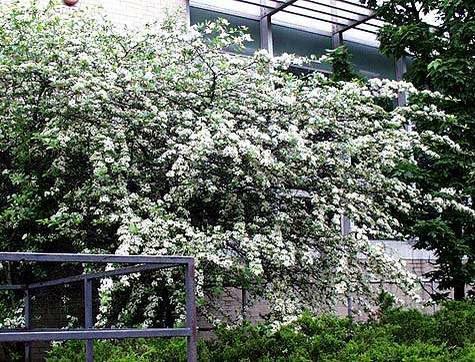Cockspur Thorn (Crataegus Crus-Galli)
Cockspur Thorn
Crataegus crus-galli, commonly called cockspur thorn, is sometimes seen as a dense, low-branched, broad-rounded tree to 25-35’ with horizontal branching armed with numerous large thorns (5-3” long). Lower branches often sweep near to the ground. It is also often seen as a tall, flat-topped shrub. It is native from Quebec to North Carolina and Kansas. In Missouri, it typically occurs in thickets and rocky pastures throughout the state (Steyermark). Obovate to oblong-obovate dark green leaves (to 3” long) have wedge-shaped bases. Foliage turns orange to scarlet to purple red in fall. White flowers (in corymbs to 3”) bloom in May for a period of 7-10 days. Flowers emit an unpleasant fragrance. Flowers are followed by rounded fruits (3/8” diameter) that ripen to deep red in fall (September-October) and typically persist to late fall. Fruits are technically edible, but are usually best left for the birds. The fruit is sometimes called a haw.
Genus name comes from the Greek name for the tree. From kratos meaning strength for its strong, hard wood.
Crus-galli in Latin means leg of a cock in reference to the purported resemblance of the thorns of this plant to a cock’s spurs. The specific epithet of this plant is sometimes also designated as crusgalli.
The white hawthorn blossom (Crataegus) is the Missouri State Flower.

Grow in average, medium moisture, well-drained soils in full sun. Tolerates a wide range of soils as long as drainage is good. Tolerates light shade and some drought. Tolerates many urban pollutants.
| Hardiness zone | 3 - 7 |
| Sun light | Full Sun |
| Water | Medium |
| Maintenance | Medium |
Pests and diseases are a problem with most hawthorns. Plants are susceptible to cedar-hawthorn and cedar-quince rusts (rust stage where eastern red cedars are present in the area) and fireblight. Other potential diseases include fungal leaf spots, powdery mildew, cankers, apple scab, leaf blight and twig blight. Potential insect pests include aphids, borers, caterpillars, lacebugs, leafminers and scale. Red spider mites may also occur. Use of pesticide sprays may be advisable in areas where this plant suffers from significant diseases and insects. On species plants, numerous thorns pose significant risks for young children and also make culture/pruning more difficult.
Small flowering landscape tree for lawns or open woodland areas. Notwithstanding disease susceptibility, a well-maintained tree can be ornamentally attractive. On species plants, thorns are a drawback for pedestrian areas or areas with small children. Plants may be effective when grown as barrier plants on property borders or in hedgerows.
| Common name | Cockspur Thorn |
| Botanical name | Crataegus Crus-Galli |
| Plant type | Tree |
| Family | Rosaceae |
| Hardiness zone | 3 - 7 |
| Water | Medium |
| Maintenance | Medium |
| Flower color | White |
| Flowering period | May |
| Height | 25 - 35 Ft. |
| Width | 25 - 35 Ft. |